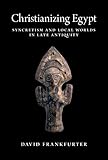Christianizing Egypt : Syncretism and Local Worlds in Late Antiquity / David Frankfurter.
Material type: TextSeries: Martin Classical Lectures ; 34Publisher: Princeton, NJ : Princeton University Press, [2017]Copyright date: ©2018Description: 1 online resource (336 p.) : 8 color illus. 16 halftonesContent type:
TextSeries: Martin Classical Lectures ; 34Publisher: Princeton, NJ : Princeton University Press, [2017]Copyright date: ©2018Description: 1 online resource (336 p.) : 8 color illus. 16 halftonesContent type: - 9780691176970
- 9781400888009
- Christianity and other religions -- Egyptian
- Syncretism (Religion) -- Egypt
- RELIGION / Christianity / History
- Acolyte
- Amulet
- Ancient Egypt
- Ancient Egyptian deities
- Apocalypse of Elijah
- Apotropaic magic
- Archaeology
- Basilica
- Burial
- Caesarius of Arles
- Cemetery
- Ceremony
- Christian art
- Christian demonology
- Christian media
- Christian monasticism
- Christian theology
- Christian tradition
- Christianity
- Christianization
- Clergy
- Deity
- Demonization
- Demonology
- Divination
- Epigraphy
- Exorcism
- Figurine
- God
- Hagiography
- Harpocrates
- Heathenry (new religious movement)
- Homily
- Household
- Iconography
- Ideology
- Image of God
- Incense
- Jews
- John Chrysostom
- Laity
- Late Antiquity
- Literature
- Liturgy
- Lord's Prayer
- Magical texts
- Mamre
- Martin Classical Lectures
- Martyr
- Menouthis
- Michael (archangel)
- Modernity
- Monastery
- Monasticism
- Mummy
- Mural
- Names of God in Judaism
- Narrative
- New Christian
- Nomina sacra
- Oberlin College
- Orthodoxy
- Oxyrhynchus
- Paganism
- Piety
- Pottery
- Prayer
- Procession
- Prophets of Christianity
- Relic
- Religion
- Religious conversion
- Religious identity
- Religious order
- Religious orientation
- Religious text
- Reuse
- Rite
- Roman Empire
- Routledge
- Saint
- Sermon
- Shai
- Shenoute
- Shrine
- Stele
- Syncretism
- Terracotta
- The Monastery
- The Various
- Theocracy
- Tomb
- Tradition
- Upper Egypt
- V
- Veneration
- Votive offering
- Worship
- Wreath
- Writing
- 200.932/09015 23
- BL2455 .F736 2018
- online - DeGruyter
| Item type | Current library | Call number | URL | Status | Notes | Barcode | |
|---|---|---|---|---|---|---|---|
 eBook
eBook
|
Biblioteca "Angelicum" Pont. Univ. S.Tommaso d'Aquino Nuvola online | online - DeGruyter (Browse shelf(Opens below)) | Online access | Not for loan (Accesso limitato) | Accesso per gli utenti autorizzati / Access for authorized users | (dgr)9781400888009 |
Browsing Biblioteca "Angelicum" Pont. Univ. S.Tommaso d'Aquino shelves, Shelving location: Nuvola online Close shelf browser (Hides shelf browser)

|

|

|

|

|

|

|
||
| online - DeGruyter Sufism : A New History of Islamic Mysticism / | online - DeGruyter Religion : What It Is, How It Works, and Why It Matters / | online - DeGruyter Hegel's Social Ethics : Religion, Conflict, and Rituals of Reconciliation / | online - DeGruyter Christianizing Egypt : Syncretism and Local Worlds in Late Antiquity / | online - DeGruyter The Dancing Lares and the Serpent in the Garden : Religion at the Roman Street Corner / | online - DeGruyter The Moral Economists : R. H. Tawney, Karl Polanyi, E. P. Thompson, and the Critique of Capitalism / | online - DeGruyter The Arabic Freud : Psychoanalysis and Islam in Modern Egypt / |
Frontmatter -- Contents -- Illustrations -- Preface -- Acknowledgments -- Abbreviations -- Chapter 1. Remodeling the Christianization of Egypt -- Chapter 2. Domestic Devotion and Religious Change -- Chapter 3. Controller of Demons, Dispenser of Blessings -- Chapter 4. A Site of Blessings, Dreams, and Wonders -- Chapter 5. The Magic of Craft -- Chapter 6. Scribality and Syncretism -- Chapter 7. Whispering Spirits, Holy Processions -- Afterword -- Bibliography -- Illustration Credits -- Index
restricted access online access with authorization star
http://purl.org/coar/access_right/c_16ec
How does a culture become Christian, especially one that is heir to such ancient traditions and spectacular monuments as Egypt? This book offers a new model for envisioning the process of Christianization by looking at the construction of Christianity in the various social and creative worlds active in Egyptian culture during late antiquity.As David Frankfurter shows, members of these different social and creative worlds came to create different forms of Christianity according to their specific interests, their traditional idioms, and their sense of what the religion could offer. Reintroducing the term “syncretism” for the inevitable and continuous process by which a religion is acculturated, the book addresses the various formations of Egyptian Christianity that developed in the domestic sphere, the worlds of holy men and saints’ shrines, the work of craftsmen and artisans, the culture of monastic scribes, and the reimagination of the landscape itself, through processions, architecture, and the potent remains of the past.Drawing on sermons and magical texts, saints’ lives and figurines, letters and amulets, and comparisons with Christianization elsewhere in the Roman empire and beyond, Christianizing Egypt reconceives religious change—from the “conversion” of hearts and minds to the selective incorporation and application of strategies for protection, authority, and efficacy, and for imagining the environment.
Mode of access: Internet via World Wide Web.
In English.
Description based on online resource; title from PDF title page (publisher's Web site, viewed 27. Jan 2023)


